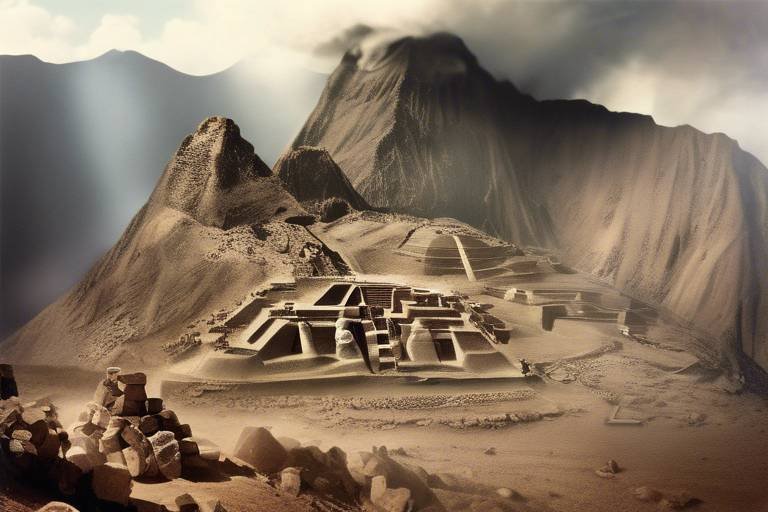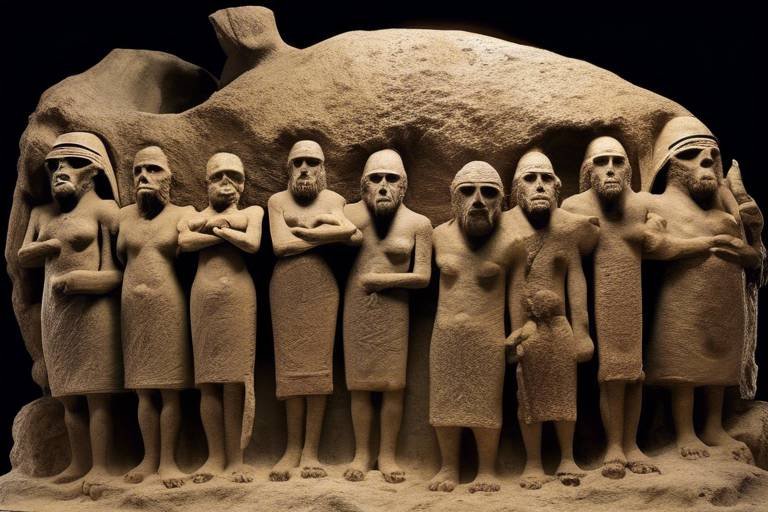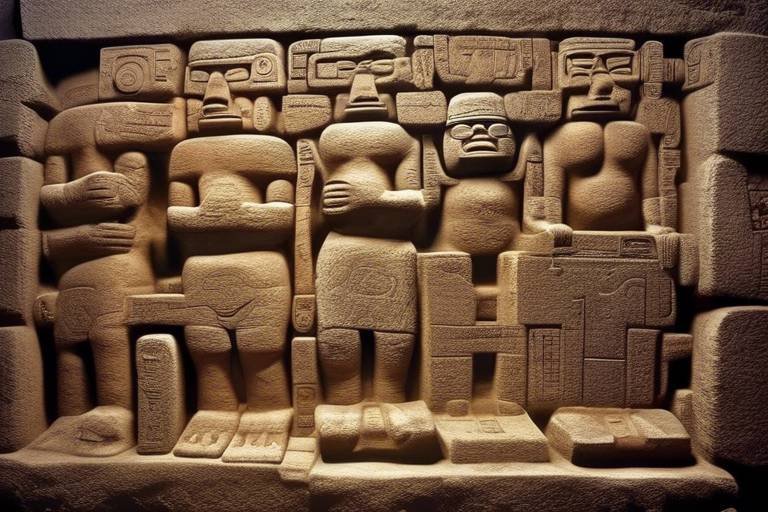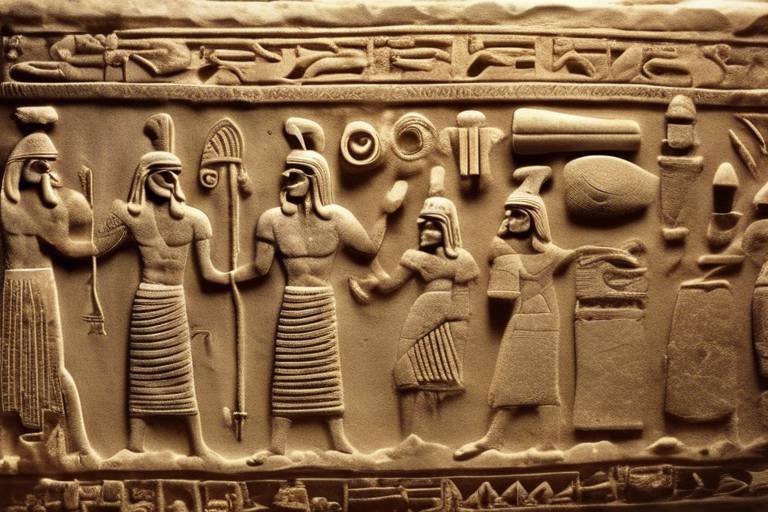The Mystery of the Lost Civilizations of the Andes
Have you ever wondered about the enigmatic civilizations that once thrived in the majestic Andes mountains, leaving behind a trail of mysterious ruins shrouded in secrets? Exploring the depths of history, we uncover the captivating tales of the lost civilizations of the Andes, each holding a piece of the puzzle to their ultimate disappearance.
From the towering heights of the Andes emerged the mighty Inca Empire, a civilization that ruled with power and grandeur, showcasing unparalleled architectural feats and ingenious agricultural practices that defied the odds of nature itself. Their legacy echoes through time, whispering tales of a bygone era filled with glory and wonder.
Venturing further into the heart of the Andean mysteries, we encounter the enigmatic Nazca Lines etched into the desert floor, a perplexing display of geoglyphs that puzzle the minds of modern-day scholars. What ancient knowledge and celestial wisdom guided the hands that crafted these intricate designs visible only from the sky?
Delving into the depths of Chavín de Huántar, an ancient ceremonial center adorned with intricate artwork and hidden underground passages, we unravel the religious tapestry woven by a culture steeped in mysticism and reverence for the unseen forces that shaped their world.
Standing as a testament to human ingenuity, the ruins of Tiwanaku in Bolivia beckon us to witness the megalithic marvels of a pre-Columbian city adorned with the enigmatic Gate of the Sun. What secrets lie buried beneath the stones, whispering tales of a civilization lost to time?
Perched high in the clouds, the iconic citadel of Machu Picchu stands as a beacon of Inca spirituality and architectural brilliance, a testament to the harmonious blend of nature and human endeavor. How did this ancient city atop the Andes mountains hold such profound significance for its creators?
Unveiling the artistic and technological prowess of the Moche civilization, we gaze upon the intricate pottery, complex irrigation systems, and enigmatic rituals depicted in their artwork, each stroke revealing a glimpse into the vibrant tapestry of their culture.
Tracing back in time, we encounter the expansive Wari culture, predecessors to the Inca Empire, whose urban planning and road networks laid the foundation for future Andean civilizations to thrive and flourish in the wake of their legacy.
Turning our gaze to the north, we delve into the mysteries of the Sican culture of northern Peru, renowned for their metallurgical skills and elaborate burial practices that speak of a society steeped in sophistication and spiritual beliefs, as exemplified by the enigmatic El Brujo complex.

The Inca Empire
The Inca Empire, also known as Tawantinsuyu, was a vast and powerful civilization that flourished in the Andean region of South America. Stretching from modern-day Ecuador to Chile, the Incas built an empire that was the largest in pre-Columbian America. Their capital city, Cusco, was the heart of their civilization and a marvel of urban planning. The Incas were renowned for their impressive stone masonry, with structures like Sacsayhuamán showcasing their advanced architectural skills. Machu Picchu, one of the most famous Inca sites, is a testament to their engineering prowess and spiritual beliefs. The Incas also developed sophisticated agricultural techniques, such as terracing and irrigation systems, allowing them to cultivate crops in the challenging mountainous terrain. Their road network, known as the Inca Road, connected distant parts of the empire and facilitated communication and trade. The Inca Empire was a highly organized society with a complex social structure, led by the Sapa Inca who was considered the divine ruler. Their economy was based on a system of collective labor known as mit'a, where citizens contributed to public works and projects. Despite their remarkable achievements, the Inca civilization met its demise with the arrival of the Spanish conquistadors led by Francisco Pizarro in the 16th century, marking the end of an era and the beginning of a new chapter in Andean history.

The Nazca Lines
The Nazca Lines are one of the most intriguing mysteries of the ancient world, etched into the barren landscape of the Nazca desert in Peru. These massive geoglyphs, created by removing the reddish-brown iron oxide-coated pebbles that cover the surface of the desert, form various shapes, including animals, plants, and geometric patterns. The sheer size and complexity of the designs have baffled archaeologists and historians for decades, leading to numerous theories about their purpose and the civilization that created them.
Some experts believe that the Nazca Lines served as an astronomical calendar, tracking celestial events such as solstices and equinoxes. The precise alignment of the geoglyphs with the movements of the sun, moon, and stars suggests a deep understanding of astronomy and mathematics by the ancient Nazca people. Others propose that the lines were part of religious rituals or ceremonies, possibly related to fertility, water, or agricultural practices.
The construction of the Nazca Lines is a remarkable feat of engineering, requiring meticulous planning and coordination. The creators of these massive designs had to scale the surrounding hills to view their work from above, indicating a high level of organization and skill. The sheer scale of the geoglyphs, some stretching over 1,200 feet in length, demonstrates the advanced knowledge and expertise of the Nazca civilization in surveying and geometric principles.
Despite the passage of centuries, the Nazca Lines have endured, preserved by the arid climate of the desert. However, they face threats from modern development, including nearby mining activities and the expansion of urban areas. Efforts are underway to protect and preserve these ancient wonders for future generations, ensuring that the enigmatic legacy of the Nazca people continues to captivate and inspire visitors from around the world.

Chavín de Huántar
Exploring the ancient cultures that thrived in the Andes mountains and the enigmatic ruins they left behind, shedding light on the mysteries of their disappearance and the advanced technologies they possessed.
Unraveling the history and achievements of the powerful Inca civilization that dominated the Andean region, including their impressive architecture and sophisticated agricultural practices.
Investigating the enigmatic geoglyphs etched into the Nazca desert, discussing theories about their purpose and the advanced knowledge of astronomy and engineering required to create them.
Exploring the ancient ceremonial center of Chavín de Huántar and its intricate underground passageways, examining the religious significance of its artwork and the mysterious culture that built it.
Examining the ruins of Tiwanaku, a pre-Columbian city in Bolivia, and its megalithic structures like the Gate of the Sun, discussing the advanced engineering skills of its builders and the theories surrounding its decline.
Delving into the iconic citadel of Machu Picchu, discussing its architectural marvels, sophisticated urban planning, and the spiritual significance it held for the Inca civilization.
Uncovering the artistic and technological achievements of the Moche civilization, known for their elaborate pottery, complex irrigation systems, and enigmatic rituals depicted in their artwork.
Exploring the expansive Wari culture that predated the Inca Empire, analyzing their urban planning, road networks, and the enduring influence they had on subsequent Andean civilizations.
Investigating the Sican culture of northern Peru, renowned for their metallurgical skills, elaborate burial practices, and the mysterious El Brujo complex, shedding light on their sophisticated society and beliefs.
The ancient ceremonial center of Chavín de Huántar, nestled in the Peruvian Andes, stands as a testament to the ingenuity and spiritual depth of its creators. The site's labyrinthine underground passageways, adorned with intricate carvings and sculptures, hint at a culture deeply connected to mystical beliefs and rituals.
Chavín de Huántar's iconic Lanzón monolith, a towering granite statue depicting a deity with feline features, symbolizes the spiritual power and reverence the Chavín people held for their gods. The complex's strategic location amidst the imposing mountains added to its mystical aura, serving as a focal point for religious ceremonies and pilgrimages.
The intricate artwork found at Chavín de Huántar, including the famous Tello Obelisk, showcases the advanced artistic skills of its creators and provides insights into their cosmological beliefs. The site's unique architecture, characterized by stone carvings and underground galleries, reflects a sophisticated understanding of construction and design that continues to intrigue archaeologists and historians.

Tiwanaku
Exploring the ancient cultures that thrived in the Andes mountains and the enigmatic ruins they left behind, shedding light on the mysteries of their disappearance and the advanced technologies they possessed.
Unraveling the history and achievements of the powerful Inca civilization that dominated the Andean region, including their impressive architecture and sophisticated agricultural practices.
Investigating the enigmatic geoglyphs etched into the Nazca desert, discussing theories about their purpose and the advanced knowledge of astronomy and engineering required to create them.
Exploring the ancient ceremonial center of Chavín de Huántar and its intricate underground passageways, examining the religious significance of its artwork and the mysterious culture that built it.
Examining the ruins of Tiwanaku, a pre-Columbian city in Bolivia, and its megalithic structures like the Gate of the Sun, discussing the advanced engineering skills of its builders and the theories surrounding its decline.
Delving into the iconic citadel of Machu Picchu, discussing its architectural marvels, sophisticated urban planning, and the spiritual significance it held for the Inca civilization.
Uncovering the artistic and technological achievements of the Moche civilization, known for their elaborate pottery, complex irrigation systems, and enigmatic rituals depicted in their artwork.
Exploring the expansive Wari culture that predated the Inca Empire, analyzing their urban planning, road networks, and the enduring influence they had on subsequent Andean civilizations.
Investigating the Sican culture of northern Peru, renowned for their metallurgical skills, elaborate burial practices, and the mysterious El Brujo complex, shedding light on their sophisticated society and beliefs.
Q: Are the Andean ruins still being discovered today?
A: Yes, ongoing archaeological research in the Andes continues to uncover new sites and artifacts, adding to our understanding of these ancient civilizations.
Q: What caused the decline of these advanced cultures?
A: The reasons for the decline of civilizations like the Inca, Moche, and others in the Andes are multifaceted and include factors such as environmental changes, warfare, and the arrival of European colonizers.
Q: How did these ancient cultures achieve such advanced architectural feats?
A: The Andean civilizations were adept engineers and architects, utilizing sophisticated techniques and a deep understanding of the local environment to create monumental structures that have stood the test of time.

Machu Picchu
Perched high in the Andes mountains of Peru, stands as a testament to the ingenuity and spiritual depth of the Inca civilization. This iconic citadel, shrouded in mist and mystery, captivates visitors with its awe-inspiring architecture and breathtaking mountain vistas. The intricate stonework of Machu Picchu, without the use of mortar, showcases the advanced engineering skills of the Inca people, who meticulously crafted the site to blend harmoniously with the natural landscape.
Walking through the stone ruins of Machu Picchu, one can't help but marvel at the sophisticated urban planning evident in the layout of terraces, temples, and residential areas. The strategic positioning of agricultural terraces and water channels highlights the Inca's profound understanding of environmental sustainability and resource management. Each stone, carefully placed, whispers tales of a civilization deeply connected to the land and the cosmos.
Moreover, Machu Picchu held profound spiritual significance for the Inca civilization, serving as a sacred sanctuary where rituals and ceremonies were conducted to honor the gods and ancestors. The Intihuatana stone, believed to be an astronomic clock or calendar, symbolizes the Inca's advanced knowledge of astronomy and their reverence for the celestial bodies. The spiritual energy that permeates Machu Picchu continues to intrigue and inspire modern-day visitors seeking a connection to the ancient past.
As the sun rises over the majestic peaks surrounding Machu Picchu, casting a golden glow over the ancient stones, one can't help but ponder the enigmatic allure of this lost city. The mysteries of its construction, purpose, and ultimate abandonment continue to puzzle archaeologists and historians, inviting endless speculation and wonder. Machu Picchu remains a testament to the enduring legacy of the Inca civilization and a reminder of the profound mysteries hidden within the Andean mountains.

The Moche Civilization
Exploring the ancient cultures that thrived in the Andes mountains and the enigmatic ruins they left behind, shedding light on the mysteries of their disappearance and the advanced technologies they possessed.
The Moche civilization, also known as the Mochica, flourished in northern Peru between the 1st and 8th centuries AD. Renowned for their artistic and technological achievements, the Moche people left a rich legacy that continues to fascinate archaeologists and historians alike. One of the most striking aspects of the Moche culture is their elaborate pottery, which depicted scenes of everyday life, ritualistic practices, and mythical creatures with exquisite detail and craftsmanship.
Moreover, the Moche were adept engineers, developing complex irrigation systems that allowed them to cultivate crops in the arid coastal desert region where they resided. This mastery of agriculture enabled the Moche to sustain a large population and build thriving urban centers characterized by monumental adobe pyramids and elaborate ceremonial plazas.
Artifacts unearthed from Moche sites reveal a society deeply entrenched in ritualistic practices and religious beliefs. The intricate artwork found in Moche tombs and temples provides insights into their complex cosmology and the significance of various deities in their belief system. The Moche also engaged in enigmatic rituals, some of which involved human sacrifice, as depicted in their vivid pottery and murals.
Furthermore, the Moche civilization had a sophisticated social structure, with distinct classes and specialized labor roles. This organizational complexity allowed them to undertake monumental construction projects and develop intricate metallurgical techniques, including the production of intricate gold and silver ornaments.
In conclusion, the Moche civilization stands as a testament to the ingenuity and creativity of the ancient Andean peoples. Their artistic legacy, technological prowess, and intricate societal structure continue to intrigue researchers and offer a glimpse into a vibrant and enigmatic culture that thrived in the challenging environment of the Peruvian coast.
Q: What led to the decline of the Moche civilization?
A: The exact reasons for the collapse of the Moche civilization remain a subject of debate among scholars. Factors such as environmental changes, warfare, and internal unrest have been proposed as possible causes.
Q: How did the Moche people influence later Andean civilizations?
A: The Moche civilization had a significant impact on the cultural development of subsequent Andean societies, influencing artistic styles, architectural techniques, and religious practices in the region.
Q: What are some of the most famous artifacts associated with the Moche civilization?
A: The Moche people are renowned for their elaborate pottery, particularly the iconic stirrup spout vessels that depict intricate scenes of daily life, rituals, and mythical beings.
Q: What is the significance of Moche metallurgy?
A: Moche metallurgy played a crucial role in the society's artistic and religious practices, with skilled artisans creating intricate gold and silver ornaments that were used in ceremonial contexts and as symbols of social status.

The Wari Culture
Exploring the ancient cultures that thrived in the Andes mountains and the enigmatic ruins they left behind, shedding light on the mysteries of their disappearance and the advanced technologies they possessed.
The Wari culture, a pre-Inca civilization that flourished in the Andes region of present-day Peru between 500 and 1000 AD, left a lasting impact on the history of the Andean civilizations. Known for their advanced urban planning and road networks, the Wari people built expansive cities and established trade routes that connected distant regions. Their architectural achievements, such as the intricate stone structures found at sites like Pikillacta and Cerro Baul, reflect their engineering prowess and organizational skills.
One of the remarkable aspects of the Wari culture was their ability to govern a vast territory encompassing diverse ecological zones. They implemented innovative agricultural techniques, including terraced farming and irrigation systems, to sustain their population and support their urban centers. The Wari also exhibited a sophisticated understanding of ceramics and textiles, producing intricately designed pottery and textiles that showcased their artistic abilities.
Despite the impressive achievements of the Wari civilization, much about their society remains shrouded in mystery. The reasons behind their eventual decline and the factors that led to the collapse of their empire are topics of ongoing research and speculation among archaeologists and historians. The legacy of the Wari culture endured through the influence they exerted on subsequent Andean civilizations, particularly the Inca Empire, which adopted and built upon many of their architectural and administrative practices.

The Sican Culture
The Sican culture, originating in northern Peru, flourished between the 8th and 14th centuries, leaving behind a legacy of remarkable metallurgical expertise and intricate burial customs. Renowned for their exceptional skills in working with precious metals like gold and silver, the Sican people crafted exquisite jewelry and ceremonial objects that reflected their advanced artistic sensibilities. Their metallurgical prowess not only served ornamental purposes but also held significant ritualistic importance, symbolizing power and status within their society.
One of the most intriguing aspects of the Sican culture is their elaborate burial practices. The discovery of elaborate tombs filled with precious artifacts and offerings shed light on their beliefs in the afterlife and the importance they placed on honoring the deceased. The elaborate funerary rituals of the Sican people showcased their reverence for the departed and their intricate understanding of spiritual realms.
Among the notable archaeological sites associated with the Sican culture is the mysterious El Brujo complex. This archaeological site revealed a wealth of information about Sican society, including their religious practices, social structure, and architectural achievements. The intricate murals and artifacts found at El Brujo provide valuable insights into the spiritual beliefs and cultural traditions of the Sican people, highlighting their sophisticated civilization.
Through their metallurgical skills, elaborate burial practices, and architectural achievements, the Sican culture demonstrated a high level of sophistication and cultural richness. Their legacy continues to captivate archaeologists and historians, offering a glimpse into a vibrant and enigmatic civilization that thrived in the ancient Andean region.
Frequently Asked Questions
- What are the Nazca Lines?
The Nazca Lines are a series of ancient geoglyphs etched into the Nazca desert in Peru. These intricate designs, ranging from simple lines to complex figures of animals and geometric shapes, are believed to have been created between 500 BC and 500 AD. The purpose behind these massive artworks remains a subject of debate among archaeologists and historians.
- How were the Inca able to construct such impressive architecture?
The Inca Empire, known for its remarkable stone structures such as Machu Picchu, utilized advanced engineering techniques without the use of mortar. They perfected the art of fitting stones together so precisely that not even a blade could pass between them. This precision, combined with their knowledge of agricultural terracing and irrigation systems, allowed the Inca to create enduring architectural marvels.
- What is the significance of the Gate of the Sun at Tiwanaku?
The Gate of the Sun is a monolithic archway located at the Tiwanaku archaeological site in Bolivia. It is adorned with intricate carvings and is believed to have served as a ceremonial or astronomical marker. The symbolism and precise astronomical alignments of the Gate of the Sun reflect the advanced astronomical knowledge possessed by the builders of Tiwanaku.
- Who were the Moche civilization and what were they known for?
The Moche civilization flourished in northern Peru between 100 and 700 AD. They were skilled artisans known for their elaborate pottery depicting scenes of daily life, rituals, and mythical beings. The Moche also constructed complex irrigation systems to support their agricultural activities, showcasing their advanced engineering capabilities.
- What sets the Wari culture apart from other ancient Andean civilizations?
The Wari culture, which thrived between 600 and 1000 AD, established a vast empire encompassing parts of modern-day Peru. They were pioneers in urban planning, creating planned cities with sophisticated drainage systems and road networks. The Wari's architectural achievements and organizational skills left a lasting impact on subsequent Andean societies.
- What were the metallurgical skills of the Sican culture known for?
The Sican culture, located in northern Peru from 750 to 1375 AD, excelled in metallurgy, particularly in the crafting of intricate gold and silver artifacts. Their advanced metalworking techniques, including alloying and soldering, produced stunning ceremonial objects and jewelry. The discovery of the Sican's elaborate burial practices and metallurgical workshops sheds light on their rich cultural heritage.



















